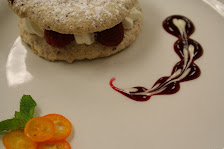Days 64, 65, 66, and 67: Melody. Rhythm. Harmony.
In a journal of superlatives such as I have created here, it is difficult to present an accurate account of this next confection. Rather than going on an on and saying things like: No, really, this one is my favorite, I will summarize in a word. Paris. It’s the Paris of desserts. It is refined and elegant, mysterious and a little proud, expensive, complicated, torrid and searingly beautiful. I’m sure there are many other desserts with the same name: Symphonie – a simple Google Image search confirms this suspicion. I defy any of them, however, to hold an audience quite as rapt as this one managed to. In a rare career crossover attempt, I shall indulge myself briefly in the obviously begged comparison of this dessert to a symphony. (For you Classical music geeks, think of it as inside-out R. Strauss.)
The basis of any solid symphony is melody (let’s not get into a musicological debate about this; just roll with me). It’s the tune people hum after the show; a mental imprint of the experience. The number this dessert sang was Chocolate and Hazelnut, a club favorite for centuries. The dress it wore was a showstopper too – a rich satin robe by Ganache, with gold accents. Everyone who was there whistled long after the show.
You have to have rhythm if you want any kind of texture. This cake was almost Bartók. From the snap of the chocolate on the bottom to the crunch of the ground hazelnuts caught up in each chocolate cake layer to the praline buttercream, smooth as silk between each one, the full spectrum of texture was available to anyone who had a bite.
Finally, the coalescence of all the elements: the harmony. Here, no dynamic was too loud, no phrasing too blatant. All the elements of this marvelous work converged in Mozartean balance, each note exactly where fate would have it put, each voice exactly where it belonged in the context of those surrounding it. It was so perfect as to seem plucked from the air.
Alright, so what the heck was it? It took us a number of days, with multiple sets of pans, mixers, freezers, and decorating supplies, to create all the elements of the symphonie. We began by painting a rectangular layer of hazelnut sponge (like a génoise) with some chocolate. Once that had set, we turned it over, making the very bottom of the cake a sheen of slightly snappy chocolate. We then moistened the cake layer with kirsch-flavored syrup, and iced it with a layer of whipped ganache. Not ordinary ganache (half-chocolate-half-cream), though. Here, we used ganache riche. (Five points to the person who can guess what riche means in French.) This ganache has a bit more chocolate in it and so imparts a deeper chocolate note. When that layer was down, we iced it again, only this time with praline buttercream, which is essentially buttercream with praline paste whipped in. Think of praline paste as peanut butter, only slightly more liquid, and made from hazelnuts. (I know; it’s pretty awesome.) Usually, in a buttercream, we would whip egg whites with sugar and eventually add (lots of) butter. For this one, though, we whipped egg yolks with sugar, and added (still lots of) butter. It made it quite as rich as you would imagine it might. Atop this second layer of filling, we placed a layer of almond cake called biscuit joconde (bis-KWEE zho-COHND). My sources tell me that “jocund,” as it would be in English, means “characterized by joyful exuberance.” I see their point. This layer was treated the same way as the lower one, with syrup, whipped rich ganache, and praline buttercream. We placed a third layer, this time hazelnut again, on top, and moistened it with syrup. At this point, we did not continue as before with a dual layer of icings, but rather with whipped ganache only, which we spread level and to exacting smoothness. The cake was then allowed to refrigerate and firm up before the final steps. The finishing touches involved pouring a sleek liquid coat of (ordinary) ganache over the top, strategically dropping some gold leaf at the corners, and, in what we were informed was the traditional way, inscribing the name of the dessert across its front, in chocolate ink from our favorite pen, the cornet. So to tally, for those including myself who have lost count, the layers from the bottom up go something like this: chocolate, hazelnut cake, whipped rich ganache, praline buttercream, biscuit joconde, whipped rich ganache, praline buttercream, hazelnut cake, whipped rich ganache, poured ganache. (Not counting syrup and decorations.)
It sounds like too much, I realize this, but once again you must trust me; it’s not. The finished cake is perhaps three inches high, each layer being incredibly thin. All these rich ingredients come together in the right proportions, and form a dessert that is perfectly balanced in weight, sweetness, flavor, and texture. One friend who picked up a piece while in her car called me from her cell phone before having bothered to swallow (I was praying she was at a stoplight), and stated that it was hands down the best cake she’d ever had. I have to say, I was in agreement. This symphonie truly lives up to its name, as so few desserts bearing such a name ever could. And after eating it, not because it was heavy but because it was so immensely satisfying, you remember another integral part of any line of music: the space in which you can luxuriate for a fleet moment, before the effects of what you’ve just experienced can be carried away by something new.
Rest.
Thursday, May 3, 2007
Subscribe to:
Post Comments (Atom)































































No comments:
Post a Comment